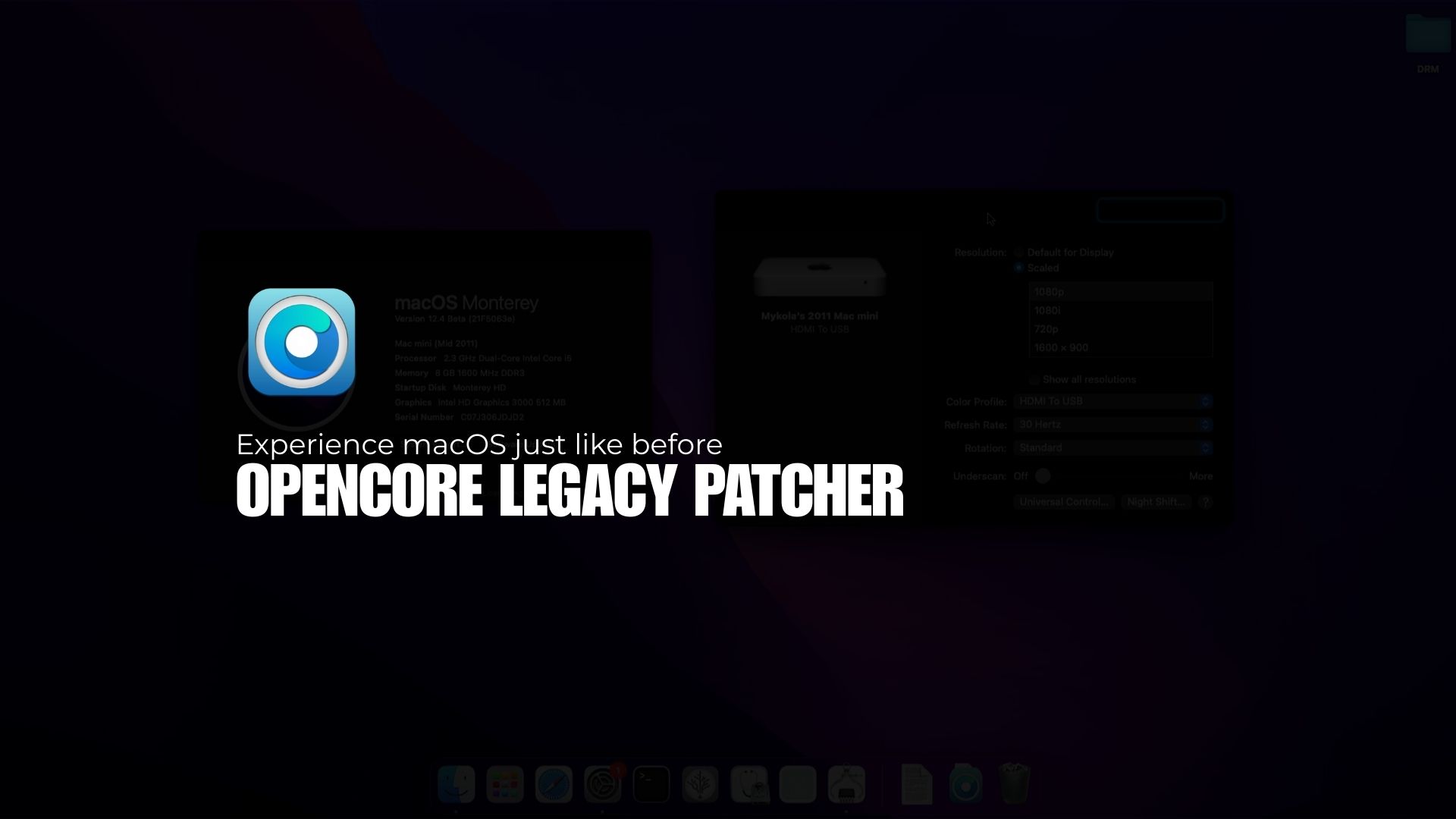
OpenCore Legacy Patcher is a tool designed for running macOS on unsupported Macs. It’s part of the OpenCore project, which is an open-source bootloader for macOS. The Legacy Patcher specifically focuses on enabling macOS installations on older Mac hardware that Apple no longer officially supports.
The primary goal of OpenCore Legacy Patcher is to provide a way for users with older Macs to install and run recent versions of macOS that would otherwise not be compatible with their hardware. It achieves this by patching certain components and creating a custom boot environment.
Keep in mind that working with tools like OpenCore Legacy Patcher involves modifying system components, and it’s crucial to follow the instructions provided by the developers carefully. Additionally, since developments in the Hackintosh community can occur rapidly, it’s a good idea to check for the latest information and updates from official sources or community forums.
What is OpenCore Legacy Patcher?

OpenCore Legacy Patcher is a software tool designed to enable the installation and operation of macOS versions beyond the official compatibility list on unsupported Macintosh hardware. This tool leverages Acidanthera’s OpenCorePkg and Lilu frameworks, offering a secure and non-invasive approach to macOS deployment.
Unlike traditional methods that require firmware modifications, OpenCore Legacy Patcher operates within the existing system framework, injecting necessary patches to overcome compatibility hurdles. This ensures system stability and facilitates seamless Over-the-Air (OTA) updates for users.
The tool supports a wide range of Macintosh hardware, encompassing vintage PowerPC machines to modern M1-based systems. This versatility empowers users to breathe new life into aging hardware, while simultaneously enjoying the latest features and functionalities offered by contemporary macOS versions.
In conclusion, OpenCore Legacy Patcher presents a valuable solution for users seeking to extend macOS compatibility beyond official limitations. Its non-intrusive nature and broad hardware support make it a compelling option for both technical enthusiasts and everyday users seeking to maximize the utility of their Macintosh devices.
Features
Unveiling a myriad of capabilities, OpenCore Legacy Patcher redefines the macOS experience on unsupported hardware. From enhanced security to seamless updates, explore the versatile features transforming older systems into dynamic, functional setups. Let’s dive into the features that the tool offers.
Free & Open-Source
OpenCore Legacy Patcher is free and open source, offering users the freedom to modify and distribute the software. This transparency fosters collaboration and ensures accessibility to a wider community of users.
Community Support
Benefiting from a strong community, this tool encourages collaborative support where users share experiences and insights, enhancing troubleshooting and contributing to an overall improved user experience.
Secure
OpenCore Legacy Patcher prioritizes security, implementing measures to ensure a stable and protected macOS installation process on unsupported hardware, safeguarding user data and system integrity.
Additional Features
From Wi-Fi to Sidecar, OpenCore magically unlocks hidden hardware compatibility, breathing new life into older Macs.
OTA Updates
supports Over-The-Air (OTA) updates; allowing users to seamlessly update their macOS installations. This feature simplifies the process, ensuring users stay current with the latest system improvements effortlessly.
OpenCore Legacy Patcher Download for macOS→
Name
OpenCore Legacy Patcher
Version
2.4.1
Released On
Sept 1, 2025
Official Source

Downloads
We do not host any file; instead, all links direct to GitHub. For other releases, refer to the GitHub releases page.
Note: OpenCore Legacy Patcher is an open-source project available on GitHub. This site serves as an unofficial resource for all information related to the software and project. Additionally, we do not host any files or resources from the project on our own servers or any third-party servers. All links direct to the official GitHub repository.
OpenCore Legacy Patcher – Installation
Installing OpenCore Legacy Patcher (OCLP) allows you to run newer versions of macOS on unsupported Macs. This guide provides a detailed, step-by-step process to ensure a smooth installation.
Prerequisites
- Supported Mac: Verify that your Mac model is supported by OCLP. Check the official list on the OpenCore Legacy Patcher site.
- USB Drive: A USB flash drive with at least 16 GB of storage.
- macOS Installer: Access to a compatible macOS installer (Big Sur, Monterey, or Ventura).
- Internet Connection: Required for downloading files.
Step 1: Format the USB Drive
- Insert the USB drive into your Mac.
- Open Disk Utility (found in Applications > Utilities).
- Select your USB drive from the list on the left.
- Click on Erase at the top.
- Set the following options:
- Name: Choose a name (e.g., “OCLP”).
- Format: Select MS-DOS (FAT).
- Scheme: Choose GUID Partition Map.
- Click Erase to format the drive. This will delete all data on it.
Step 2: Download OpenCore Legacy Patcher
- Download the latest version of OCLP (e.g.,
OpenCore-Legacy-Patcher-0.x.x.app). - Extract the downloaded file if it’s in a compressed format.
Step 3: Launch OpenCore Legacy Patcher
- Open the OCLP application you just downloaded.
- You may need to allow it through your Mac’s security settings if prompted.
Step 4: Create macOS Installer
- In OCLP, click on Create macOS Installer.
- Select Download macOS Installer if you don’t have one already, or choose Use Existing macOS Installer if you have downloaded it previously.
- Follow the prompts to select your desired macOS version and wait for it to download (this can take some time).
Step 5: Install to USB Drive
- After downloading, select your formatted USB drive in OCLP.
- Click on Install to USB Drive.
- Enter your admin password when prompted.
- The installation process will take some time as OCLP creates a bootable EFI partition and copies necessary files to the USB drive.
Step 6: Install OpenCore to Disk
- Once installation completes, OCLP will prompt you to install OpenCore to disk.
- Select this option and choose your USB drive again for installation.
- Confirm and wait for the process to finish, which may include verifying files.
Step 7: Reboot and Access OpenCore
- After installation, reboot your Mac.
- Immediately hold down the Option (⌥) key while your Mac is starting up.
- In the boot picker menu, select the OpenCore EFI option (it will have an OpenCore logo).
Step 8: Install macOS
- After selecting OpenCore, you will be taken to another boot picker where you can choose your macOS installer from the USB drive.
- Proceed with the installation as you would normally do with any macOS setup.
- Be aware that modern installations may require several reboots; if it restarts and returns to the beginning of the installation process, simply reboot and select the incomplete install option from OpenCore’s boot picker.
Step 9: Post-Installation Checks
- Once macOS is installed, launch OCLP again from your Applications folder.
- Run any necessary post-install patches as instructed by OCLP to ensure full functionality of your hardware.
Conclusion
By following these steps, you can successfully install OpenCore Legacy Patcher on an unsupported Mac, allowing you to enjoy newer versions of macOS without hardware limitations.
Common Issues and Troubleshooting for OpenCore Legacy Patcher
OpenCore Legacy Patcher (OCLP) is a powerful tool for running newer versions of macOS on unsupported Macs, but users may encounter various issues during installation or operation. Here are some common problems and solutions:
OpenCore Legacy Patcher Not Launching
- Issue: The application doesn’t start, indicated by the icon bouncing in the Dock.
- Solution: Launch OCLP via Terminal with the following command:bash
/Applications/OpenCore-Patcher.app/Contents/MacOS/OpenCore-Patcher
Permission Errors When Creating USB Installer
- Issue: Users may receive a “You don’t have permission to save…” error.
- Solution: Ensure the application has the necessary permissions or try running it as an administrator.
Stuck on Unsupported Version Message
- Issue: Users may see “This version of Mac OS X is not supported on this platform.”
- Solution: Verify that your hardware is compatible with the macOS version you are trying to install.
Cannot Boot macOS Without USB
- Issue: The system fails to boot without the USB installer.
- Solution: Ensure that the root patches have been correctly applied and that the EFI folder structure is intact.
Infinite Recovery OS Booting
- Issue: The system gets stuck in a recovery boot loop.
- Solution: Attempt to reset NVRAM/PRAM by holding down Command + Option + P + R during startup.
System Version Mismatch Error During Root Patching
- Issue: A “version mismatch” error occurs when attempting to root patch.
- Solution: Use the “PurgePendingUpdate” tool available on Discord to resolve pending updates that may be causing the issue. Disabling automatic macOS updates is recommended after recovery1.
Unable to Resolve Dependencies (Error Code 71)
- Issue: This error often indicates problematic kernel extensions.
- Solution:
- Open Terminal and run:bash
sudo zsh cd "/Volumes/Macintosh HD/Library/Extensions" && ls | grep -v "HighPoint*\|SoftRAID*" | xargs rm -rf - Alternatively, manually delete offending extensions from
/Library/Extensionswhile keeping necessary ones1.
- Open Terminal and run:bash
No Graphics Acceleration or Black Screen Issues
- Issue: Users may experience no graphics acceleration or a black screen after updates.
- Solution: Check if the correct graphics drivers are installed and ensure that any Metal GPU swaps are properly configured.
Wi-Fi Connectivity Problems
- Issue: Inability to connect Wi-Fi, especially with legacy cards on newer macOS versions.
- Solution: Ensure that legacy wireless patches are applied correctly, and check compatibility with your specific hardware1.
Keyboard, Mouse, and Trackpad Not Functioning
- Issue: Input devices may not work during installation or after updates.
- Solution: Try connecting different USB ports or devices, and ensure that all necessary drivers are installed.
FAQs
How does OpenCore Legacy Patcher enable macOS on unsupported Macs?
OpenCore Legacy Patcher modifies system components, creating a custom boot environment to facilitate macOS installations on older, unsupported hardware.
Is it safe and legal to use OpenCore Legacy Patcher?
OpenCore Legacy Patcher is considered a grey area in terms of legality, as it circumvents Apple’s official hardware compatibility requirements. However, it operates within the existing system framework and doesn’t modify your Mac’s core functionality. As for safety, it’s generally considered safe if followed correctly but proceed with caution and thorough research before attempting any modifications.
What are the benefits of using OpenCore Legacy Patcher?
Extends macOS compatibility: Breathe new life into older Macs by running the latest macOS versions.
Non-intrusive patching: No need for risky firmware modifications, ensuring system stability and Over-the-Air updates.
Hardware versatility: Supports a wide range of Macs, from PowerPC to M1-based systems.
Advanced features: Unlock boot customization, hardware compatibility tweaks, and deeper system control.
Are there any risks associated with using OpenCore Legacy Patcher?
Technical complexity: The process requires some technical knowledge and troubleshooting skills.
Potential software conflicts: Patches might not always be perfect and could lead to software incompatibility.
Warranty voiding: Using unofficial tools might void your Mac’s warranty.